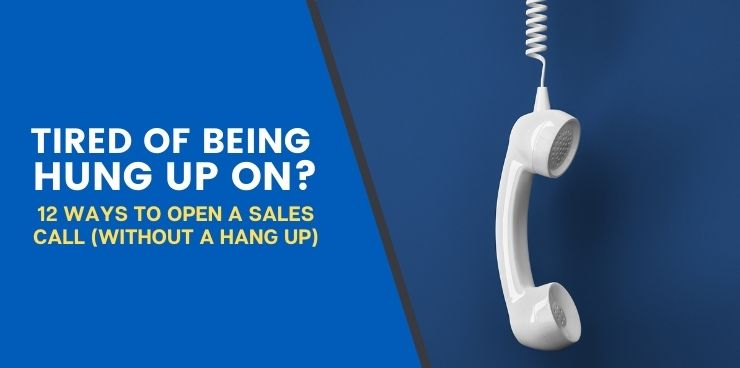Remember dinner with the family being interrupted by a ringing telephone? You put down your fork, wipe your mouth and pick up the phone.
“Hello?”
“Hi, I wanted to talk to you about upgrading your cable package…”
“Thank you, but please, take me off the list.”
Luckily, these meal-disrupting cold-calls seem to have all but disappeared in consumer settings. But, sales calls are alive and kicking in B2B selling, and customers find them equally exasperating. Numerous sales reps still have to deal with low sales call success rates and frequent confidence-shattering hang ups.
As frustrating as sales calls are for customers and salespeople alike, their potential and purpose keeps them relevant. As opposed to consumer sales calls, business inbound sales calls are at least expected. Despite the irritation, business decision-makers still prefer phone calls over alternatives like sales emails or faxes.
For a sales rep trying to fabricate relationships out of thin air, phone calls can be effective and efficient. To keep potential customers engaged, a lot rides on the opening. First impressions significantly impact the direction of a call, with your closing ability being partially dictated in the early minutes.
As a potent tool in the salesperson’s arsenal, phone calls require strategic design to get results. While you want to avoid robotic approaches to cold-calling, there are some tried and true sales call steps. Read on for the top 12 ways to open a sales call that keep prospects on the phone.
 Why Is a Sales Call Opening Important?
Why Is a Sales Call Opening Important?
Sales calls carry a lot of benefits over other channels. Starting a sales discussion from scratch is awkward, whether it is by email, text or phone. Despite the undue criticism, sales calls are one of the best ways to start productive conversations.
In value-based selling, the sales call is heavily favored. Even the majority of executive decision-makers say they find value in quality sales calls. Let’s look at some different ways that sales calls benefit the salesperson and the buyer:
Sales Calls Make It Easy To Ask Qualifying Questions and Speed Up the Sales Cycle.
Think about communicating via email, text or social media chats. You ask questions and wait minutes, hours or even days for responses, if you get them at all. For qualifying leads and getting elaborate details, this can be incredibly inefficient.
Sales calls are fast and productive. Sales reps are able to cut right to usable information that reveals pain points and indicates a good fit. They can ask appropriate follow-ups and position their solution within a matter of minutes.
Sales Calls Add the Human Element.
Having a phone conversation is more personable than text communication. The sales rep can display their personality, indicate their interest more effectively and remove ambiguity. This all helps create a stronger connection and lay the foundation for a positive relationship.
Sales Calls Are Convenient and Can Be Done at a Higher Volume.
Meetings can certainly accomplish the prior points but they are nowhere near as convenient as calls. Setting up a meeting requires tight coordination, exhaustive preparation and potentially hours out of your prospect’s day.
For initial sales conversations not supported by a clear fit, meetings can be overkill and poor uses of everyone’s time. Sales reps may work five or more sales calls into a day but only one or two meetings. When you are trying to fill a sales funnel, meetings are not the best route.
From the prospect’s standpoint, their time is valuable, and they appreciate the convenience of the sales call. When you set up a meeting, you risk damaging a relationship if you fail to deliver real value.
When done right, sales calls open you and your prospect up to more engaging conversations. By capturing interest and displaying value, you can increase the chances of subsequent meetings and conversion. To get the most out of your opening, keep these sales tips in mind for your next prospecting call:
- Introduce yourself with a warm, professional greeting.
- Engage their thinking by asking a question or illustrating intriguing situations.
- Use active listening, checking for non-verbal cues and asking for details in open ended questions.
- Ask for next steps and confirm expectations, whether it is another call or an in-person meeting.
Effective Ways to Open a Sales Call
The best openings to sales calls make you and your prospect comfortable. As you get accustomed to the cadence of sales calls, you should develop your own style. When you have your own custom approach, you not only build authenticity but also consistency and subsequent efficiency.
It is hard to tell what might work when you try to develop your own sales methods and scripts. To help you get started, try experimenting with these 12 effective ways to open a sales call:
Pre-Call Preparation
Pre call planning is critical if you want to contend for a customer’s time and money. Having information on your contact, the specifics of their business and their needs keeps you from making costly mistakes.
Research your prospect thoroughly before reaching out. Check their social media presence and their company’s website. Learn as many personal and professional details as possible.
By learning about the contact and their business, you can reflect their values and interests to create connections. More importantly, you gain an understanding of the challenges they may face and how you can solve them.
Sales call planning entails the material and content you bring to the call. You need to offer unique value within your conversation to get the prospect wanting more. Make sure you have any valuable marketing collateral on hand and in mind to supply at the right moment.
Take stock of your sales call goals and create a comprehensive talk track. Design your questions and the flow of the call to quickly get the results you need. Determine the desired action you need from the prospect and make sure to confirm the details. It is never good when you end calls only to realize you forgot something important.
Start With a Friendly Greeting
Sales calls are anticipated, and prospects are pretty quick to develop attitudes about everyday sales pitches. You can, however, catch prospects off guard with how warmly you greet them.
Instead of saying “Hi John, how are you?”, try starting with “Hi John, how have you been?” Greeting prospects in this way gives them pause, causing them to consider if they know you. This is where your research pays off. You can greet them by name and drop relevant personal points to create a connection.
It is crucial to keep the greeting warm but succinct. Hanging onto small talk gets tedious quickly, especially if the prospect is sniffing a sales pitch. This can quickly devalue the offer you have to make.
 Bring Up Your Company Knowledge
Bring Up Your Company Knowledge
Prospects are impressed by a greater breadth of knowledge about their industry, brand, competition and needs. When you talk about the research you have done, you display credibility and concern. For instance, you could start off a conversation like this:
“From what I have found, your organization is currently facing (challenge)…”
Showing your interest makes your call seem more purposeful — you have a good reason to call them. Prospects stay on the line because they perceive greater value and are willing to repay the effort.
Mention a Mutual Associate
Bringing up a shared connection immediately transfers trust and credibility. The associations they make with your mutual acquaintances are put on you.
The mutual connection can also give you leverage, an organic reason to get on a sales call. This works especially well if they and the prospect are in the same line of business. You could open with a reference like this:
“I was having lunch with a friend of yours, [Name], and they mentioned you might be interested in [solution]…”
By approaching the sales call like this, you make your offer sound more tailored and more exclusive.
Pull Valuable Information from LinkedIn
LinkedIn should be a primary focus for salespeople trying to own their inbound lead generation. The information on a prospect’s LinkedIn profile highlights their interests and professional goals. These contain key details to include in a sales conversation to make your offer relevant and personalized.
Talk About the Competition
Bringing up direct competitors can pique a prospect’s curiosity, making them move forward with the call. If you talk about a prior partnership with a competitor and the results you gained, you add validity.
Ask your contact if they want to discuss how they can achieve similar or better results. Through your tone, it should be apparent that your company offers legitimate solutions.
Expose the Prospect’s Pain Points
When talking about the competition, you can also relay the shared challenges that can be resolved. Giving your solution context backed up by data shows proof of its effectiveness. The prospect will be engaged, thinking about the possibilities of using your product to solve their issues.
Use Strategic Small Talk
Small talk is useful in breaking down barriers, taking control of the conversation and building rapport. The great thing about sales calls is that you can attach your voice and emotion to it. Couple this with interest in a prospect’s personal side and you seem more genuine and down-to-earth.
Be mindful of how you use small talk. As good as it is at building connections, too much of it will be exhaustive.
Bring Up Points From Their Marketing Content
Talking about the prospect’s company and their marketing activity shows active consideration. Mention a recent social media post, news story or blog article. Doing so shows your level of research and relevance to their immediate concerns. Anything you have to say will seem more useful.
Bringing up company data you pulled from blogs or newsletters can also trigger business conversations. If they discuss opportunities or challenges, you can fit in your solution as relevant to achieving their goals. You could approach it like this:
“I was reading your latest newsletter and saw you were looking to expand your territory…”
Change the Narrative
Most sales calls, and sales interactions in general, make the sales rep seem like the helper. When you make it seem like the potential customer is doing you a favor, they are likely to enthusiastically respond. Make the favor simple and easily achievable but show your emphatic appreciation. Try saying it this way:
“I was wondering if you could do me a small favor that would help me out a ton.”
Ditch the Typical Tactics
Sales calls are met with skepticism and irritation. Prospects know there’s a pitch underneath the small talk, so sometimes it is best to own that up front. Lose the standard approach and try saying “Hi [Name], you guessed right, this is a sales call.” Saying something to that effect will blindside the prospect. Their automatic response to sales calls has to be abandoned, and they will often reply with a joke.
Customer Maintenance
There is work to be done after the sales call to keep the relationship moving. Follow ups add personal touches, especially if you take time to write thank you letters after a meeting. They also give you a chance to establish a schedule for future calls.
After closing, you can use your relationship to ask for referrals and get feedback on your offerings. You should also keep in touch with lost deals. Needs and capabilities change, so they may benefit from your solutions later.
Sales calls deserve a sales training focus, measurement and ongoing optimization. Getting to a close in sales is reliant on your sales team’s initial conversations. They set the framework for the customer’s journey through the sales funnel. With these sales call techniques and call analytics to continually improve, you will more consistently achieve your goals.
Whether you run a business start up or an established company, there is always room for growth. At the Selling Revolution, we leverage our years of experience in winning sales to boost performance at every level. From hiring to creating sales processes and even training on sales calls, we offer comprehensive custom solutions. To learn how we can help you overcome sales challenges to reach your true potential, book a call today.


 Why Is a Sales Call Opening Important?
Why Is a Sales Call Opening Important? Bring Up Your Company Knowledge
Bring Up Your Company Knowledge